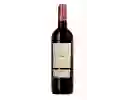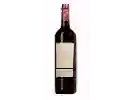
Winery Georges VigourouxLe Temps des Vendanges Malbec - Merlot
This wine is a blend of 2 varietals which are the Malbec and the Merlot.
This wine generally goes well with poultry, beef or game (deer, venison).
Wine flavors and olphactive analysis
On the nose the Le Temps des Vendanges Malbec - Merlot of Winery Georges Vigouroux in the region of South West often reveals types of flavors of earth, spices.
Food and wine pairings with Le Temps des Vendanges Malbec - Merlot
Pairings that work perfectly with Le Temps des Vendanges Malbec - Merlot
Original food and wine pairings with Le Temps des Vendanges Malbec - Merlot
The Le Temps des Vendanges Malbec - Merlot of Winery Georges Vigouroux matches generally quite well with dishes of beef, game (deer, venison) or spicy food such as recipes of stuffed zucchini, rabbit à la lorientaise or homemade pork curry.
Details and technical informations about Winery Georges Vigouroux's Le Temps des Vendanges Malbec - Merlot.
Discover the grape variety: Malbec
Malbec, a high-yielding red grape variety, produces tannic and colourful wines. It is produced in different wine-growing regions and changes its name according to the grape variety. Called Auxerrois in Cahors, Malbec in Bordeaux, it is also known as Côt. 6,000 hectares of the Malbec grape are grown in France (in decline since the 1950s). Malbec is also very successful in Argentina. The country has become the world's leading producer of Malbec and offers wines with great potential.
Last vintages of this wine
The best vintages of Le Temps des Vendanges Malbec - Merlot from Winery Georges Vigouroux are 2016, 2018, 2015, 2017 and 2014.
Informations about the Winery Georges Vigouroux
The Winery Georges Vigouroux is one of of the world's great estates. It offers 90 wines for sale in the of South West to come and discover on site or to buy online.
The wine region of South West
The South-West is a large territorial area of France, comprising the administrative regions of Aquitaine, Limousin and Midi-Pyrénées. However, as far as the French wine area is concerned, the South-West region is a little less clear-cut, as it excludes Bordeaux - a wine region so productive that it is de facto an area in its own right. The wines of the South West have a Long and eventful history. The local rivers play a key role, as they were the main trade routes to bring wines from traditional regions such as Cahors, Bergerac, Buzet and Gaillac to their markets.
News related to this wine
Chablis: #locationmatters by Yang LU
On December 10, 2020, four Hong Kong personalities discussed Chablis wines on a live webinar: Yang LU, Master Sommelier and Official Bourgogne Wines Ambassador, Debra MEIBURG, Master of Wine, Ivy NG, Official Bourgogne Wines Ambassador and Rebecca LEUNG, wine expert. In this first 90-second clip, Yang LU explains how location is the key to understanding “Why Chablis is special”. #Chablis #PureChablis ...
The Saint-Véran appellation seen by Kevin Tessieux
Kévin Tessieux, President of the appellation’s winegrower union, shares his perspective on the Saint-Véran appellation and tell us about the origin of its name. This video is taken from the “Rendez-vous avec les vins de Bourgogne” program broadcasted in June 2021. Retrouvez-nous sur les réseaux sociaux : Facebook : https://www.facebook.com/VinsdeBourgogneofficiel Twitter : https://twitter.com/VinsdeBourgogne Instagram : https://www.instagram.com/vinsdebourgogne/ LinkedIn: https://www.li ...
The Morey Saint Denis appellation investigated through its geology and geography
The Bourgogne Wine Board (BIVB) invites you to enjoy this video in which Jean-Pierre Renard, Expert Instructor at the Ecole des Vins de Bourgogne, explains the topographical and geological characteristics of the Morey-Saint-Denis appellation. The vineyard lies on an intensely fractured area. Several characteristic zones can be distinguished, we can say that each Climat has its own personality. This video is taken from the “Rendez-vous avec les vins de Bourgogne” program broadcasted in April 2021 ...
The word of the wine: Rootstock
American vine on which a French vine is grafted. This is the consequence of the phylloxera that destroyed the vineyard at the end of the 19th century: after much trial and error, it was discovered that the "pest" spared the roots of the American vines, and the technique became widespread.














